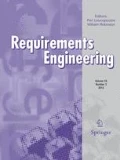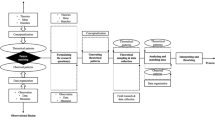Abstract
The creation of domain models from qualitative input relies heavily on experience. An uncodified ad-hoc modeling process is still common and leads to poor documentation of the analysis. In this article we present a new method for domain analysis based on qualitative data analysis. The method helps identify inconsistencies, ensures a high degree of completeness, and inherently provides traceability from analysis results back to stakeholder input. These traces do not have to be documented after the fact. We evaluate our approach using four exploratory studies.


Similar content being viewed by others
Notes
References
Achouri C (2015) Human resources management: eine praxisbasierte Einführung. Springer, New York
Balzert H (2010) Lehrbuch der softwaretechnik: Basiskonzepte und requirements engineering. Springer, New York
Bazeley P (2013) Qualitative data analysis: practical strategies. Sage, Newbury Park
Becker M (2009) Personalentwicklung-bildung, förderung und organisationsentwicklung in theorie und praxis. 5. erw. Aufl. Stuttgart. Schäffer-Poeschel Verlag, S 546
Blaauboer F, Sikkel K, Aydin MN (2007) Deciding to adopt requirements traceability in practice. In: Krogstie J, Opdahl AL, Sindre G (eds) Advanced information systems engineering. Springer, pp 294–308
Bolloju N, Leung FS (2006) Assisting novice analysts in developing quality conceptual models with uml. Commun ACM 49(7):108–112
Broy M (2013) Domain modeling and domain engineering: Key tasks in requirements engineering. In: Münch J, Schmid K (eds) Perspectives on the future of software engineering. Springer, pp 15–30
Byrd TA, Cossick KL, Zmud RW (1992) A synthesis of research on requirements analysis and knowledge acquisition techniques. MIS Q 16:117–138
Carvalho L, Scott L, Jeffery R (2005) An exploratory study into the use of qualitative research methods in descriptive process modelling. Inf Softw Technol 47(2):113–127
Chakraborty S, Dehlinger J (2009) Applying the grounded theory method to derive enterprise system requirements. In: 10th ACIS international conference on software engineering, artificial intelligences, networking and parallel/distributed computing, 2009. SNPD’09. IEEE, pp 333–338 (2009)
Chakraborty S, Rosenkranz C, Dehlinger J (2015) Getting to the shalls: facilitating sensemaking in requirements engineering. ACM Trans Manag Inf Syst TMIS 5(3):14
Charmaz K (2014) Constructing grounded theory. Sage, Newbury Park
Cheng BHC, Atlee JM (2007) Research directions in requirements engineering. In: 2007 future of software engineering, FOSE ’07. IEEE Computer Society, Washington, pp 285–303. doi:10.1109/FOSE.2007.17
Cleland-Huang J, Gotel OC, Huffman Hayes J, Mäder P, Zisman A (2014) Software traceability: trends and future directions. In: Proceedings of the on future of software engineering. ACM, pp 55–69
Corbin J, Strauss A (2014) Basics of qualitative research: techniques and procedures for developing grounded theory. Sage, Newbury Park
Corbin JM, Strauss A (1990) Grounded theory research: procedures, canons, and evaluative criteria. Qual Sociol 13(1):3–21
Cruzes DS, Vennesland A, Natvig MK (2013) Empirical evaluation of the quality of conceptual models based on user perceptions: a case study in the transport domain. In: Ng W, Storey VC, Trujillo JC (eds) Conceptual modeling. Springer, pp 414–428
Daoust N (2012) UML requirements modeling for business analysts: steps to modeling success. Technics Publications, Denville
Dvir D, Raz T, Shenhar AJ (2003) An empirical analysis of the relationship between project planning and project success. Int J Proj Manag 21(2):89–95
Francis JJ, Johnston M, Robertson C, Glidewell L, Entwistle V, Eccles MP, Grimshaw JM (2010) What is an adequate sample size? Operationalising data saturation for theory-based interview studies. Psychol Health 25(10):1229–1245
Gibson B, Hartman J (2013) Rediscovering grounded theory. Sage, Newbury Park
Glaser BG (1978) Theoretical sensitivity: advances in the methodology of grounded theory. Sociology Press, Mill Valley
Glaser BG, Strauss AL (2009) The discovery of grounded theory: strategies for qualitative research. Transaction Publishers, Piscataway
Gotel O, Cleland-Huang J, Hayes JH, Zisman A, Egyed A, Grünbacher P, Dekhtyar A, Antoniol G, Maletic J (2012) The grand challenge of traceability (v1.0). In: Cleland-Huang J, Gotel O, Zisman A (eds) Software and systems traceability. Springer, pp 343–409
Guion LA (2002) Triangulation: establishing the validity of qualitative studies. Extension Institute of Food and Agricultural Sciences, Gainesville, FL. http://www.rayman-bacchus.net/uploads/documents/Triangulation.pdf. Accessed 27 Sept 2009
Halaweh M (2012) Application of grounded theory method in information systems research: methodological and practical issues. Rev Bus Inf Syst (Online) 16(1):27
Halaweh M (2012) Using grounded theory as a method for system requirements analysis. JISTEM J Inf Syst Technol Manag 9(1):23–38
Hofmann HF, Lehner F (2001) Requirements engineering as a success factor in software projects. IEEE Softw 18(4):58
Hruschka P (2014) Business analysis und requirements engineering: Produkte und Prozesse nachhaltig verbessern. Carl Hanser Verlag GmbH & Co. KG. ISBN-13: 978-3446438071
Hughes J, Wood-Harper T (1999) Systems development as a research act. J Inf Technol 14(1):83–94
Insfrán E, Pastor O, Wieringa R (2002) Requirements engineering-based conceptual modelling. Requir Eng 7(2):61–72
Kelle U (2010) The development of categories: different approaches in grounded theory. The Sage handbook of grounded theory. Sage, Newbury Park, pp 191–213
King N, Horrocks C (2010) Interviews in qualitative research. Sage, Newbury Park
Larman C (2005) Applying UML and patterns: an introduction to object-oriented analysis and design and iterative development. Pearson Education India, Delhi
MacQueen KM, McLellan E, Kay K, Milstein B (1998) Codebook development for team-based qualitative analysis. CAM J 10(2):31–36
Mempel B (2014) Definition einer DSL mittels QDA, Master thesis, self published
Myers MD, Newman M (2007) The qualitative interview in is research: examining the craft. Inf Organ 17(1):2–26
Mylopoulos J, Chung L, Nixon B (1992) Representing and using nonfunctional requirements: a process-oriented approach. IEEE Trans Softw Eng 18(6):483–497
Nohl AM (2013) Narrativ fundierte interviews. In: Bohnsack R, Flick U, Lüders C, Reichertz J (eds) Interview und dokumentarische Methode. Springer, pp 13–26 (2013)
Nuseibeh B, Easterbrook S (2000) Requirements engineering: a roadmap. In: Proceedings of the conference on the future of software engineering. ACM, pp 35–46
Pidgeon NF, Turner BA, Blockley DI (1991) The use of grounded theory for conceptual analysis in knowledge elicitation. Int J Man Mach Stud 35(2):151–173
Poels G, Maes A, Gailly F, Paemeleire R (2005) Measuring the perceived semantic quality of information models. Springer, New York
Pohl K, Rupp C (2011) Requirements engineering fundamentals: a study guide for the certified professional for requirements engineering exam-foundation level-IREB compliant. Rocky Nook Inc, San Rafael
Prieto-Díaz R (1990) Domain analysis: an introduction. ACM SIGSOFT Softw Eng Notes 15(2):47–54
Rosenberg D, Stephens M (2007) Use case driven object modeling with UML. APress, Berkeley
Rupp C, Queins S et al (2012) UML 2 glasklar: Praxiswissen für die UML-Modellierung. Carl Hanser Verlag GmbH Co KG, Munich
Rupp C et al (2014) Requirements-Engineering und-Management: Aus der Praxis von klassisch bis agil. Carl Hanser Verlag GmbH Co KG, Munich
Ryschka J, Solga M, Mattenklott A (2010) Praxishandbuch Personalentwicklung: Instrumente, Konzepte. Springer, Beispiele
Schmidt A, Kunzmann C (2006) Towards a human resource development ontology for combining competence management and technology-enhanced workplace learning. In: On the move to meaningful internet systems 2006: OTM 2006 workshops. Springer, pp 1078–1087
Strauss A, Corbin J et al (1990) Basics of qualitative research, vol 15. Sage, Newbury Park
Strübing J (2004) Was ist grounded theory? In: Bohnsack R, Flick U, Lüders C, Reichertz J (eds) Grounded theory. Springer, pp 13–35
Thom N, Zaugg RJ (2009) Moderne Personalentwicklung: Mitarbeiterpotenziale erkennen, entwickeln und fördern. Springer, New York
Thomas K, Bandara AK, Price BA, Nuseibeh B (2014) Distilling privacy requirements for mobile applications. In: Proceedings of the 36th international conference on software engineering. ACM, pp 871–882
Verner J, Cox K, Bleistein S, Cerpa N (2005) Requirements engineering and software project success: an industrial survey in Australia and the us. Aust J Inf Syst 13(1):225–238
Wacker JG (1998) A definition of theory: research guidelines for different theory-building research methods in operations management. J Oper Manag 16(4):361–385
Wallace L, Keil M (2004) Software project risks and their effect on outcomes. Commun ACM 47(4):68–73
Wazlawick RS (2014) Object-oriented analysis and design for information systems: modeling with UML, OCL, and IFML. Elsevier, Amsterdam
Werner J, DeSimone R (2011) Human resource development. Cengage Learning, Boston
Würfel D, Lutz R, Diehl S (2015) Grounded requirements engineering: an approach to use case driven requirements engineering. J Syst Softw 117:645–657
Acknowledgements
We would like to thank Katharina Kunz, Florian Schmitt and Benjamin Mempel for their valuable contributions executing the exploratory studies. We would also like to thank all anonymous interview partners as well as Siemens Healthcare, Deutsche Bahn and the openETCS project for participating in our studies and providing valuable feedback to improve our method. Finally, thanks to Hannes Dohrn, Maximilian Capraro, Michael Dorner, Nikolay Harutyunyan and Daniel Knogl for workshopping this paper to improve its presentation, and to Ann Barcomb for proofreading.
Author information
Authors and Affiliations
Corresponding author
Rights and permissions
About this article
Cite this article
Kaufmann, A., Riehle, D. The QDAcity-RE method for structural domain modeling using qualitative data analysis. Requirements Eng 24, 85–102 (2019). https://doi.org/10.1007/s00766-017-0284-8
Received:
Accepted:
Published:
Issue Date:
DOI: https://doi.org/10.1007/s00766-017-0284-8




